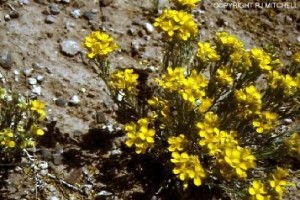Lesquerella fendleri (Brassicaceae) is a small perennial common in the deserts of the southwestern USA. The 15 mm diameter yellow flowers are simultaneously hermaphroditic, and are self-incompatible. Pollination in the field is accomplished by small bees and beeflies foraging for nectar and pollen.
 My studies on Lesquerella fendleri have been conducted at the Sevilleta Long Term Ecological Research Station, at the Sevilleta National Wildlife Refuge, an hour’s drive south of Albuquerque, NM, USA.
My studies on Lesquerella fendleri have been conducted at the Sevilleta Long Term Ecological Research Station, at the Sevilleta National Wildlife Refuge, an hour’s drive south of Albuquerque, NM, USA.
Publications involving Lesquerella fendleri:
1997. Mitchell, RJ. Effects of pollination intensity on Lesquerella fendleri seed set: variation among plants. Oecologia 109:382-388.
Cabin, RJ, AS Evans, DL Jennings, DL Marshall, RJ Mitchell, AA Sher. Using bud pollinations to avoid self-incompatibility: evidence from three mustards. Canadian Journal of Botany 74:285-289.
1996. Evans, AS, RJ Mitchell, R Cabin. Effects of gibberellic acid on seed germination and seedling morphology in Lesquerella fendleri. American Journal of Botany 83:543-549.
1995. Mitchell, RJ & DL Marshall. Effects of pollen proximity on the stigma on paternal success in Lesquerella fendleri. American Journal of Botany 82:462-467.
Roll, JR, RJ Mitchell, RJ Cabin, DL Marshall. 1997. Reproductive success increases with local density of conspecifics in the desert mustard Lesquerella fendleri. Conservation Biology 11: in press
Mitchell, RJ. 1997 Effects of pollen quantity on progeny vigor: evidence from Lesquerella fendleri. Evolution. In press
Cabin, R, AS Evans, RJ Mitchell. Do dormant and germinating seeds differ in vigor? The case of Lesquerella fendleri. American Midland Naturalist. In Review
